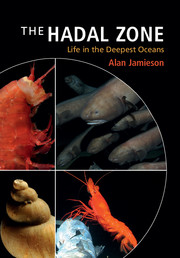Book contents
- Frontmatter
- Dedication
- Contents
- Preface
- Acknowledgements
- Part I History, geology and technology
- Part II Environmental conditions and physiological adaptations
- 4 The hadal environment
- 5 Hydrostatic pressure
- 6 Food supply to the trenches
- Part III The hadal community
- Part IV Patterns and current perspectives
- Appendix
- References
- Index
- Plate section
4 - The hadal environment
from Part II - Environmental conditions and physiological adaptations
Published online by Cambridge University Press: 05 February 2015
- Frontmatter
- Dedication
- Contents
- Preface
- Acknowledgements
- Part I History, geology and technology
- Part II Environmental conditions and physiological adaptations
- 4 The hadal environment
- 5 Hydrostatic pressure
- 6 Food supply to the trenches
- Part III The hadal community
- Part IV Patterns and current perspectives
- Appendix
- References
- Index
- Plate section
Summary
Menzies (1965) made the first attempt at reviewing the environmental conditions in the deep sea. Whilst considered a milestone review of its day, it was largely based on limited point-source observations. The review was later updated and revised in light of subsequent global studies of a more holistic nature (e.g. Tyler, 1995; Thistle, 2003). The Tyler (1995) review highlights the heterogeneity of conditions on both small and large scales and temporal variations, in contrast to the previous perception of a physically stable and unchanging environment (Sanders, 1968). To add further to the reviews of Menzies (1965) and Tyler (1995), this chapter will detail what is currently known about the environmental conditions required for the existence of life in the hadal trenches.
Deep-water masses and bottom currents
There are two forces driving deep-water currents in the deep sea; thermohaline and tidal (Tyler, 1995). The water masses flowing through the deep oceans are illustrated in the ‘great ocean conveyer belt’ diagram, published in Natural History in 1987 (see Broecker, 1991; Rahmstorf, 2006). Although this diagram has become famous, it represents a simplistic illustration of ocean circulation for the layperson. However, as a basis for understating the global circulation of water masses throughout the world’s trenches, it does serve as an ideal starting point. While there are now multiple complex studies into deep-water masses and their interaction with other stratified water masses and underlying topography, on a global context the diagram illustrates the main features: cold surface waters in the Antarctic descend and become deep bottom waters that flow up the western Pacific Ocean, through most of the world’s trenches. As this water flows north it warms, causing it to rise towards the surface again in the North Pacific Ocean before flowing west towards the Indian Ocean. This warmed surface water flows up the Atlantic Ocean, cools once more and descends to the bottom and flows southward back down the Atlantic as bottom water. Thus, the ‘thermohaline conveyer belt’ leads to a net transfer of heat from the south to the north (Berger and Wefer, 1996).
- Type
- Chapter
- Information
- The Hadal ZoneLife in the Deepest Oceans, pp. 75 - 91Publisher: Cambridge University PressPrint publication year: 2015



